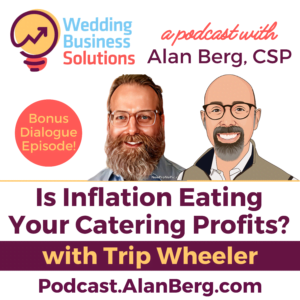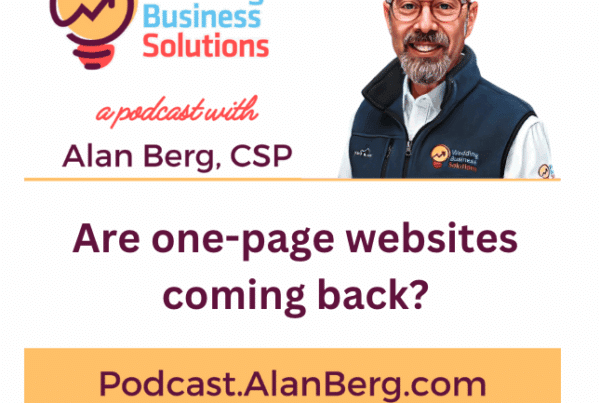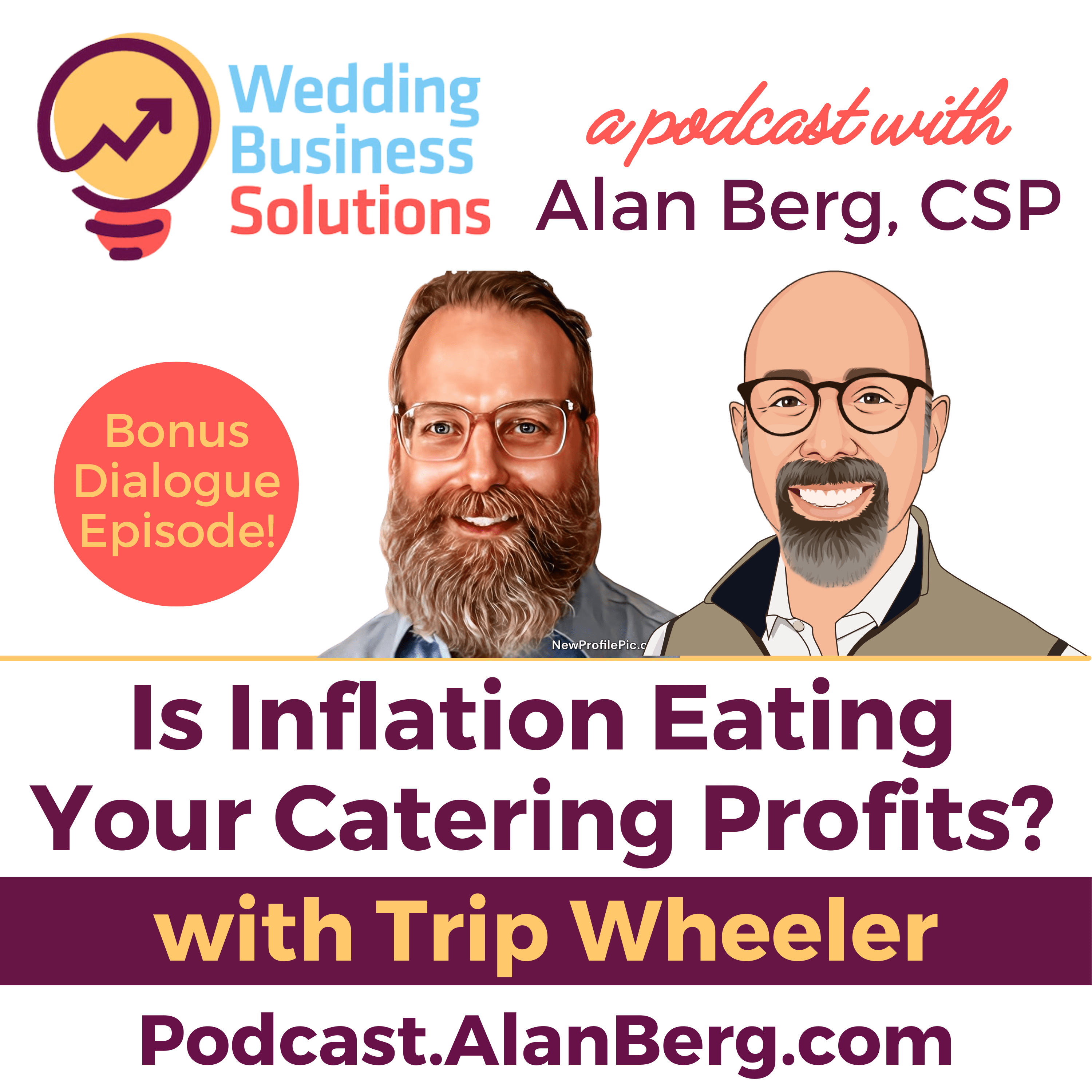 Trip Wheeler – Is inflation eating your catering profits?
Trip Wheeler – Is inflation eating your catering profits?
Inflation has taken a bite out of the profits of every wedding and event business. It’s not just food and supplies, it’s gas, shipping, supply chain disruptions and more. I invited Trip Wheeler back on to talk about what the future might bring, and to share his expertise, since his business is all about saving caterers on your food and supplies. He has some tips and thoughts, no matter what your line of work.
About Trip Wheeler and SB Value
About SB Value: With over 23,000 customers and a combined food spend of over $7B, their customers, caterers in the US, use this leverage to negotiate better prices than any single caterer could get on your own. There is no cost to join (I know, sounds crazy, but true). We get paid by the manufacturers for bringing them you much leverage. You buy what you want. You can opt out at any time. You just spend less on your food which increases your profit with no effort. It’s one of those rare times where it sounds too good to be true, but it’s not. Join many of Alan’s clients who use SB Value to save on your food and supplies. Contact Trip directly or go to https://www.wegrowvalue.com/alanberg – see how much your catering company can save.
Contact Trip Wheeler
E: [email protected]
P: 704.904.9000
https://www.wegrowvalue.com/alanberg
About Trip: I worked in sports for 20 years helping F500 companies understand how to use sports to grow their sales. Some of my clients included VISA, Proctor and Gamble, Gillette, Miller, Coleman, Lowe’s, AT&T. In 2008 I gathered 400 sporting facilities together to create leverage and buy better. That’s where I found Premier. After that we just represent the GPO side of the business because it’s such a good idea.
Listen to this and all episodes on Apple Podcast, YouTube or your favorite app/site:
- Apple Podcast:
- YouTube: www.WeddingBusinessSolutionsPodcast.tv
- Spotify: https://spoti.fi/3sGsuB8
- Stitcher:
- Google Podcast:
- iHeart Radio: https://ihr.fm/31C9Mic
- Pandora:
Below is a full transcript. If you have any questions about anything in this, or any of my podcasts, or have a suggestion for a topic or guest, please reach out directly to me at [email protected] or contact me via text, use the short form on this page, or call 732.422.6362
Please be sure to subscribe to this podcast and leave a review (thanks, it really does make a difference). If you want to get notifications of new episodes and upcoming workshops and webinars, you can sign up at www.ConnectWithAlanBerg.com
– Is inflation eating into your wedding profits? Listen to this episode and find out some ideas. Hi, it’s Alan Berg. Welcome back to another episode of “The Wedding Business Solutions Podcast.” I am so happy to have my friend Trip Wheeler back on with me again. Trip, how you doing?
– Great, Alan. Happy New Year and happy 2023.
– Well, thanks to you as well. We’re recording this right after the new year. It’s going to go out a little bit right after that. And I brought Trip back on because, Trip, the company that you have helps people save on their food and supply costs. But this is, a lot of people are listening that are not that. But I just wanted to talk about the things, because you have your finger on this pulse about what happened, you know, during Covid and what happened that kind of surprised everybody there. Because we’re used to prices going up. But what was different about this?
– I think it was a culmination of things. I think if you even talked to some of the top economists in the country, I think they’re still even a little bit confused about how it all happened. But, you know, when Covid hit, we had all the supply, you know, manufacturers know what to produce and how much to produce every month, every quarter, every day to fill their needs. Because you know, if you can sell a million pounds of something, you can’t produce two because it’ll go bad. So, they, they have a really good idea of like just-in-time inventory about what to do. But man, when the pandemic hit, all the demand was gone. And so everybody shut down, and they didn’t know what to do, Alan. And so they just said, “Well, we’re just going to shut down everything.” Well, that was bad because then nothing got produced. And then when it came back, they didn’t have any manpower. They didn’t have supplies. The machinery didn’t work. I mean, it came back way too fast. And then inflation just exploded last, what was it, last fall? I think, no, it might have been the fall of ’21, I think is when it started to come back. And no one expected to come back then, and they didn’t expect it to come back so fast. And so literally there were no turkey production facilities, no transportation facilities, no slaughter houses were open. There was no gas supply, there was no nothing. So, it wasn’t one thing, it was a hundred things that made prices just, like I said, explode. It was the perfect storm, if you will, of economic behavior.
– Yeah, because you had truckers, you see all the time they say they need more truck drivers, more truck drivers, more truck drivers. Then you have the rails. Then you have the boats stuck outside the ports because there’s nobody to unload the boats.
– Nobody could unload the ports, exactly. I mean the boat breaks down, there’s nobody to fix the boat. There’s nobody to manufacture the part to fix the boat.
– Right.
– That was everywhere. I mean, it was impressive, and it was unheard of.
– Right. So, you mentioned just-in-time inventory. For people that don’t know what that is, the car business had learned this a long time ago as well, which is instead of stockpiling the raw materials, you get the raw materials right as you need to use them. And when things are-
– Yeah, because it saves on warehouse space. It saves all your warehouse space. You just pay FedEx to bring it to you the day you need it or within a day, fix it, and then you get another one and another one, and you don’t have to warehouse anything.
– Right. So, with the food industry, obviously you can’t stockpile too much, but you can stockpile some things, you know, packaging materials and stuff like that. But I mean, think about what happened to the auto industry. They couldn’t make them because the chips, right?
– Right.
– You have all the big pieces.
– Exactly right.
– But it’s a chip. And when you think about it, it may not not have been the chip that ran the engine. It may have been the chip that ran the radio. It might have been the chip that ran-
– Yeah, or the ABS braking.
– Right.
– You can’t have a car without brakes.
– Right, and they had 99% of the parts, but they didn’t have the chips. So, it’s all these things that came together there. But we’ve had kind of this unprecedented, at least in our lifetimes, you know, and that’s long enough, with our gray beards here. That’s long enough. But in our lifetimes, this really big jump all of a sudden, the lack of supply and the jump in prices all of a sudden, and what hit our industry, and you can speak to this certainly, is all of these people that had contracts that said, “I’m going to provide, I’m going to do these weddings at events at this price,” with no provision for changing the price, right? So, what did you hear on that?
– That’s exactly right. And most of the people we talked to said, “I’ve never had to have a contract with that stipulation or that rider in it with that flexibility.” Because prices would go up one to 2%, 3%. I would build that into my budget. I’d book your wedding a year out, Alan. If prices, the worst that happens is 3% rise in food prices. I can eat that, that’s fine. But when prices are 17% up, 25% up, I can’t. And then my labor prices are up, my food prices are up, my gas prices are up for my vehicles, my heating and air is up. All of a sudden, everything’s up 17%. Not only can you not eat it, you’re going to lose a lot of money on that event. It was, again, this is probably going to be said a lot in this podcast, but it was unprecedented. No one had ever seen it before, so they’d never had to plan for it before.
– Right. And the other thing I saw people early on in the pandemic, people were panicking a little bit and they were cutting their prices that they were selling for.
– Yep.
– Right, so all kinds of different services.
– Generally a bad move, but yep.
– Right, generally a bad move, but again, you understand the panic, but it’s the same thing what happens with the stock market. People sell when it goes down, which is the wrong thing to do. They buy when it goes up, which is the wrong thing to do. And this is kind of what happened. And I was telling people, “Listen, you know, don’t panic. Don’t just lower your price, because then you’re going to have to do those events.” And that was 2022. People doing more events than they’ve ever done.
– Yep.
– Losing money because of the prices of the food and supplies if that was-
– Yep.
– You know, that was your industry there then, then having to live those events that they sold cheap.
– Yep.
– You know. That was again, hopefully a lesson learned, a hard lesson.
– For all of us, yep.
– And a hard lesson learned over there. and then we have exasperation, exacerbation, I should say, with Ukraine. All of a sudden people didn’t realize-
– Yep, that was definitely part of it, yep.
– How much wheat came from Ukraine. I mean people, you know, who ever thought about that, right? We think about we have the-
– And fertilizer. Everything is grown with fertilizer. So, I mean, Ukraine makes not all the fertilizer, but they make a lot of the fertilizers. So, all of a sudden, you know, the American food industry is very scientific. They’ve got it figured out. They know how much fertilizer, how much sun, how much water, how much everything. And they’ve got it. Well, when you do that kind of disruption, the guy says, “Hey, I can’t get you 25% of your fertilizer.” He says, “Well, what do you want me to do? I mean, then I can’t grow 25% of my crops or my crops are 25% smaller. And again, I think another thing that’s so pertinent in this conversation, Alan, is that it wasn’t just the fertilizer. Once he had the crops grown, then he couldn’t get it down because he didn’t have labor. Then he couldn’t get it on the truck. Then it spoiled cause he couldn’t get it to the distribution center or the manufacturing center. Then he couldn’t distribute it. I mean, it wasn’t one thing, it was a hundred, and it was just-
– Right.
– They couldn’t get themselves out of it.
– Yeah. So, going back to what we said about the contract before, I had a client call me up and said, “Could you help me with wording on something?” I said, “Sure, what do you need?”
– Yep.
– They said, “Well, we want to tell our clients, for our,” this in 2022, “That we’re going to be raising the price on their weddings and events because of the price of food and supplies.” I said, “Well, before we have that discussion, does your contract allow for that?” And she said, “Oh, I don’t know. Let me go back and look.” And she called me back and said, “No, it doesn’t allow for that.” I said, “Okay, well going forward, here’s kind of what you want to say in there, but of course talk to your attorney and have that in there. But you want to have a provision that says that.” But I also asked her a question. And I don’t know if you had this discussion with anyone. I said, “Have your prices ever gone down between the time you contracted with someone an event came?” And they said yes. I said, “Have you ever lowered anybody’s price?” And they said no. I said, “Well now you want to raise it.”
– Right.
– With the additional profits you made, did anybody come to you with that as well, asking you how to word that stuff?
– And to me, Alan, I had one of our smarter clients call and say that exact thing and said, “The way I’m going to talk to my client about it is, is that I have to put this new provision in there, but if prices go down, you’ll get that savings too.” So, then it was fair. Look, if if prices go up 5%, I’m paying 5% more. You got to pay 5% more. If prices go down 5%, I’m going to give it back to you. I’m not going to make 5% more profit. And they said that it really was well-received for the most part with their client base.
– Right. The thing is, how do you prove that, right? Because your price might have gone down 5% on this food thing, but your gas prices went up, right? So, now do you average that out?
– It’s hard.
– Right. I think, you know, as a business, going forward, we would hope we wouldn’t see at 17%, 25% jump like this again. And if you’re planning 2024, 2025, that you’re charging enough that if you are a DJ, that your fuel costs are in there and yet your equipment’s going to go up and your supplies, and if you’re a dress shop that you’re going to have to get the dresses going to cost you more to get them in there from imported and stuff like that. So, you would hope that you’re planning for that stuff in the future if you can.
– Yep.
– You should always plan that your rent’s going to go up, your utilities are going to go up, you know, things like that. So, what do you see on the horizon? What do you see coming?
– It’s going to slow down. it’s already started to slow down. The worst inflation period of this year, ’23, is going to be this quarter. And then it’s going to progressively get better. Economists are pretty good about projecting out 12 months. Beyond that it gets pretty sketchy. Like that hurricane spaghetti map, you know, it gets wider and wider and wider. It’s the same thing. They feel pretty confident that inflation should be mapped more back in that 3 to 4% range, which is typically acceptable from a US government standpoint. It’s still high. They want one to two, but three to four is okay. Above three to four they call it super inflation. And that’s obviously your hyperinflation. That’s not good. And that’s what we’ve witnessed from the back quarter of ’21, all of ’22, like bonkers inflation. But it’s finally starting to settle down, and you’re actually going to see some prices go down this year below what you’re currently paying. So, you’re going to see some relief on some segments.
– And what kind of segments would you think?
– I would say that, let me look at some of these details. I’ve got a bunch of charts in front of me. So, the first quarter we’re going to see a 3 to 5% range for the whole year. I think for poultry, it’s going to come down. Poultry prices have been off the charts bad, and they’re going to start coming down. Eggs, pork, turkey, they said between 3% but probably more likely in the back half of the year, they’re actually going to see deflation. They’re going to see prices decrease, not just go up by 3 and 5%. We’re going to see prices go down on, let me see this big chart. So, the negatives are going to be almost all the poultry items. Beef is going to be that 3 to 4% range going up. Almost all your beef. Pork are going to see a pretty significant deflation, decrease in price 3 to 4 to 5%. Which is, you know, still going to push us above where we were in 2019. So, it’s a little bit all over the board, but poultry down, pork down. Dairy probably flat. Disposables up but not that much. And beef up, but again, not that much.
– Yeah. And then we’ve already seen gas prices come down.
– Dramatically.
– Yeah, I mean I was in-
– Diesel’s gone down a lot.
– Yeah, diesel’s gone down. I was in Texas and I was, see, what did I fill up? I filled up my rental car at $2.39 for regular.
– That’s amazing.
– Yeah, that was crazy, because for me, just right now it was $3.17 here in New Jersey, although I didn’t have to pump, but it was $3.17. But $2.39. I had seen $2.79. I was like, “Woo, look at $2.79.”
– That’s where we are, is $2.79. And so I was pretty happy about that. Because we were almost five, or maybe even low fives.
– Oh yeah, well my son in San Francisco, and his car takes premium.
– About $7.
– It’s $7, I mean yeah, absolutely. And you know, we complain about that, but if you go to Europe and you were just in Europe, you go to Europe and you look at the prices there, it’s way more than here. And this is kind of this interconnectivity. The other thing that you don’t think about is if you are getting stuff from out of the country, there’s also the exchange rate.
– Yep.
– Now, the good news is the dollar has been strong. The bad news is the dollar’s been strong, which means that your imported goods cost more.
– Yep.
– Like what I was over in Ireland and the Euro had gone below the dollar, and it’s usually about $1.07, $1.09, $1.05, whatever. And the pound had come down to like $1.07, which is ridiculous because it’s normally $1.21, $1.25 or something like that. So, things were cheap for me.
– Yeah, but bad for here.
– But expensive for them. Right, expensive for them.
– Yep. You really got to watch what you’re buying, yep.
– Right, and how you’re buying it. I actually had euros, but I was using my credit card because the euros, it was going to cost me euro for euro. The credit card, it was actually going to cost me less because of the exchange rate.
– We did the exact same thing. We did everything on a credit card. I was like, “Well…”
– Right, yeah. But this is the interconnectivity of the world. So, many things that the supplies, we’re not just talking about caterers and venues here, thinking about everybody else that’s in here. You know, where are you getting your paper from if you’re doing invitations? Where are you getting your dresses from? Where are you getting your speakers from, and stuff like that. This is that interconnectivity. So, besides caterers, does it make sense, or how would you even word it, let’s say, if you were a band or a DJ that was say, or a photographer, videographer, that if prices go up, your price is going to go up. I don’t even know how you would word that.
– Rephrase it, are you saying like-
– So, we know with a caterer you’re saying, “Listen, you know, our prices went up 17%. We’d like to protect ourselves putting it into a contract that if prices go up for your 2024 event, I can raise your price even though your contract-“
– How does a DJ do the same thing?
– Yeah, how does the DJ?
– He doesn’t have food prices.
– Right.
– Well, I think a lot of the increase, you know, this goes without saying, but I mean a lot of the food increases are because of base things like labor. So, labor is in everything. Labor, the shortages of labor have increased gas prices. Shortages of labor have increased gas prices because you can’t produce as much gas, you can’t refine as much gas, you can’t transport as much gas. So, the DJ has the exact same problem-
– Right.
– As the caterer buying food. So, if I buy an iPhone, a pen, a water bottle, a lot of those increases are from the exact same thing. The labor shortages on manufacturing, delivery, that kind of thing. Here’s the other thing, Alan. So, my wife and I just renovated a home. And as you know, home renovation prices are crazy bad. And a guy yesterday asked me, and he goes, “Do you think prices are going to come down on renovations?” I said no. And I said, “Well, eventually, but no, not now.” He goes, “Why?” And I said, “Because there’s still too much demand.” If you’ve got a plumber who can work one job a week or two jobs a week and he’s got 20 people asking for the same job, he’s never going to discount anybody.
– Right.
– He’s probably going to raise prices. I’ll give you a stat that’s mind boggling. And this is so counterintuitive. Prior to the pandemic, there was $1 trillion in disposable, let me give you the exact number. There was $1 trillion in cash that people had in Q4 of 2019. That amount of money now is $4.7 trillion. So, you and me are like, I want a car and there’s one Toyota Tundra, but there’s 10 of us that want it. Well the dealership’s not going to lower the price.
– No, they’re getting over sticker price.
– Exactly. So, he’s going to charge $10,000 and ask you for 12 and me for 14 and that guy from $15,000. And until you and I stop spending money…
– Right.
– So, the demand is really, it’s, problem is the wrong word, but we, you and I, are somewhat causing it. Our caterers and a lot of our clients, because we sell to high schools and colleges and everybody. They had record years or record quarters in the third quarter of this year. Record.
– Yeah.
– Well that means the demand’s coming from the public to buy those services. DJ services, dance rental services, tent rentals, catering services. Well, why would prices go down?
– Right.
– When the tent guy’s got 100 orders and he’s only got 10 weekends, he’s going to charge the max amount he can, because he knows the sun’s going to set here pretty soon and he’s going to be sitting and going, “Well, here’s the recession. I wish I’d made more money in that Q3 of 2022 when I had the demand.” Well they did. So, that’s a big thing of it.
– And that brings up something that I’ve been talking about for a long time, is at least for weddings and events, let’s just talk about weddings here. We know that the demand is going down because it has to. There wasn’t this backlog.
– Yep.
– 2022 was the biggest number of weddings in our lifetime. We will never see that again.
– Yep.
– Which means 2023 could have some overlap from 2022, but by 2024 we’re back to-
– Agreed.
– BC. I call it BC, Before Covid.
– Exactly right. ’24, ’25, I’m with you. I think it’s going to take that long for the car industry to settle down, the house industry to settle down, for people to spend that $4.7 trillion, a lot of that to get washed out in the economy, and then normalcy, whatever that is.
– Well, but see, but here’s the thing. The car industry is a good example of what’s happening there and should be happening in the wedding and event industry. They’re realizing that they can make more money by producing less vehicles.
– Correct, correct.
– Right, and they’re trying, they have to build factories for electric and all that kind of stuff brings in all kinds of things. And right-sizing. And I think right before this episode goes out, there’s one with Rod McMahon who’s a friend and a client of mine in Canada who has brought down the size of his entertainment company and he’s profiting more by doing less events.
– I’ve heard that. Not a lot, but I’ve heard the exact same thing from some of our clients.
– Right, and and this is the thing, this is the right-sizing thing, and this is where you can control this as a business. Bigger is not always better, right? Bigger is just bigger. And the lesson learned, if you look at, I’ll use a simple example. If I drive through McDonald’s, the menu is so much smaller than it was before Covid. I can’t get a grilled chicken sandwich. I can’t get a salad, right? Things that you could get before, and that makes it easier for them to order, easier for them to produce, easier than for to train people.
– Storage, everything.
– Right, and the same thing in the wedding and event industry. So, Rod at one point could have done 20 weddings on a day, and now the most he can do is eight, and he said eight is uncomfortable now. Whereas before, he could have done 20.
– Yep.
– Because he doesn’t want to max out. He’d rather have six or seven, and then if he needs a backup for somebody, he’s got that.
– But he picks the best six or seven.
– Right, best six or seven.
– The most profitable, the easiest to work with.
– Right. And this is a conversation I have all the time. So, swinging this all the way around to the fact that how is inflation, you know, affecting your business, finding the right number and the right price, because that’s going to be another thing. People raised their prices during Covid, which is good. Can you sustain that? And one of the ways you sustain it is by pulling back on your availability.
– Yep.
– Billing your calendar more. So, before we go, because you and I could talk about this forever.
– And I’d love it, yeah, I agree.
– Tell people what you do. In case they didn’t hear the last episode that we did, which is if you look back to an earlier episode on, that’s actually one of the first ones that we did, I think in 2021. But Trip, you know, what is your company and what do you do?
– Sure. We have a company called SB Value. We, really simply, we’re a group purchasing organization, a GPO. We are US Foods’ largest client. We are 25%, almost 26% of US Foods’ entire volume, with $8 billion in spend, not quite 8 billion, and about 28,000 clients. We do exactly what every listener would do if they had 28,000 locations and spent $8 billion a year on food or $8 billion on anything. You would use leverage to get better prices. That’s it. We just happen to do it for people, give them the prices. And they don’t pay us, we get paid by the manufacturers. So, big companies are GPOs. Walmart, Lowe’s, it doesn’t matter. Home Depot, those are big GPOs. They use leverage to buy things cheaper than you and I can, Alan. If you and I buy a two by four, we’re going to buy one two by four. So, you’re going to pay five bucks for it. But if you buy 2 billion board feet of two by fours, you’re going to pay 50 cents for that two by four. Well that’s all the premier does. So, it’s very simple. And I will say one thing, Alan, right before you asked me that, you talked about cutting supply from a company standpoint, a DJ, a wedding producer. Tyson did the same thing. Reynolds Wrap did the same thing. They had a hundred SKUs, they reduced it to 25. And now they’ve gone back up to 50 and they’ve looked at the other 50 and thought, “We weren’t really making much money on that one anyway.” And I had factories and people, and you know what, we’re just not even going to make that plastic bag anymore. We’re going to make three plastic bags instead of 10. And it’s made their business better. And those are really big companies with a lot of smart intelligence. And I would suggest that all of us think the same thing about right-sizing.
– Yeah, and it’s, you’re looking at the data. If you look at the data, it’s actually a great book. Mike Michalowicz who wrote “Profit First,” which I’ve spoken about many times, that everybody listening should read, “Profit First” by Mike Michalowicz, also has a book called “The Pumpkin Plan.” And he tells the story about if you grow a giant pumpkin for the state fair, what you do is you buy seeds from previous winners. It’s kind of like, you know, the stud horse, right?
– Yep, exactly.
– And you plant them and you feed them and you do all the right things, and then pumpkins grow on the ground on a vine.
– Yep.
– And then you look for which ones are growing better and you cut off the runts, you cut off the little ones, until you’re left with just the one or two that are getting all the nutrients and all everything. And it’s the same thing with your business. Something I’ve done over the years is there are things that I might be good at but I don’t enjoy. Or I enjoy but they’re not profitable, and I don’t offer them anymore. I don’t do those services because they suck energy and focus away from the other things. So, same thing, you know, with your business. I have a good friend, Bill Herman, hopefully Bill’s listening to this. He’s a DJ emcee. That’s all he does. No lights, no sparklers, no anything. Does what he does at the top of the game of, you know, the highest of what you can do on that. You want the other stuff, he knows people. He’ll refer you to other people.
– Yep.
– So, look at your business and say, “What’s sitting on shelves that’s costing me money? What are people not buying? What, you know, am I lowering my price?” I had this conversation every time I do sales training. Do I offer my lower package on a Saturday in October, which is the most popular wedding days of the year?
– No.
– Right. And I was with a group of venues the other day, and this one person said, “Yeah. This the packages we offer, and if somebody had a 40-person wedding and booked it a year in advance, we took it.” I said, “Stop that.”
– Yep.
– You’re throwing money out the window. So, it’s, listening to a previous episode, I talk about your A dates, B dates, and C dates. On your A dates, this one DJ told me, “Alan, I heard you talk about this. And on a Saturday in October, I only offer my top package. And guess what?”
– And don’t discount by a dollar.
– Right, and guess what?
– Yeah.
– And when he tells people this is the only thing available on that day, he fills the dates.
– Exactly right.
– He’s averaging twice as much.
– They should hire you, and you know, Alan, the MLBs, the NFLs that have finally come around to this, you know, what they call live pricing. And so on Saturday in the beautiful fall day, that price is going to be the highest for that baseball game. There’s 80 home games. But that Tuesday noon game, when it’s four degrees below zero, it’s $3 just to get in. Because they’re going to make money on tickets and parking and everything else. They don’t care. But when it’s the Yankees versus the Cubs and it’s October, it’s sky high.
– Crazy.
– There’s no packages, there’s no discounts. And that’s exactly what they should do. Look at the entire calendar year, find out where your events are, your A events, your B events and C events, and price them accordingly and say if you need a 20% discounted price, I’m not going to give it to you on my A date. I’ll give them to you on my B dates or my C dates.
– Right, right.
– That’s what they’re worth.
– Right. And again, that’s just again, part of right-sizing is also looking and saying, you know what? I tell people, I asked this one DJ who was going from part-time to full-time. And I said, “So, how many weddings do you want to do in the full year?” He goes, “As many as possible.” I said, “Eh, wrong answer.”
– Yeah, wrong answer, yeah.
– You don’t know your inventory. If you don’t know your inventory, how do you maximize your profits?
– Look at Ford. Ford stop producing cars.
– Yeah.
– They’re making so much money on trucks and SUVs. Look at the price of trucks now. I mean, I like trucks. I’ve been buying trucks my whole life. You could buy a nice pickup truck for 25 grand. You can’t buy a truck for less than $50,000 now. That’s the base model. Like, now the nice ones are 90 grand.
– Yeah, it’s crazy.
– 100 grand for a truck. Like-
– Right.
– But I mean, because they can get it.
– Well, they can get it. Although I did hear they’re producing the regular Mustang another year.
– They are.
– They gave them one more. They kept saying no, and then they gave them one more year.
– That was the only car they were going to keep. But I mean they got rid of the Escort and the, you know, you and I both sold cars. So, the Fiesta and all that gone. Because there’s no money in an $8,000 car. There’s a ton of money in a $58,000 truck.
– That’s right.
– Just like the more money in a $58,000 wedding than there is for an $8,000 wedding.
– And the car dealers are seeing, you know, you look at the car lots and there’s empty spots on the car lots. And yet you walk in, friends of mine went in, they were going to get a Range Rover. And the guy said, “What you see is what we have.”
– Yep.
– “I don’t know what I’m getting or when. And when you look at the window sticker, add $10,000.”
– I bought a used Toyota. I was on a waiting list for six months. I prepaid the damn thing, couldn’t get it. And I finally gave up and just went and found, and I didn’t get the car I wanted. I didn’t get it because I was like, “Well, I got to have a truck. I got to have a car.” And I just took what I could get. I mean, and in two years, that guy’s going to be begging me to buy a car, or four years.
– Right.
– And now that’s the thing is that none of us, as human beings, we’re impatient. You know, if anything, be patient. If you just slow down and make your money now, prices will drop.
– Right.
– They will drop. It’s just going to take a while.
– Right, right. Again, in investing, they call it dollar cost averaging. You buy when it’s it’s high, you buy when it’s low, but you’re always buying over there. So, and I said last thing and we went another five minutes here already. So, I’m going to put into the show notes Trip’s contact information with SB Value. If you are a caterer in the United States and you have not had Trip’s company do a free comparison to show you how much you’re saving.
– Exactly.
– I had one of my customers after Trip, he signed up with Trip and again, it costs nothing to sign up. Said, “Next time I see you, you get a big kiss. On the lips, on the cheek, it’s up to you, but you get a big kiss for how much money I’m saving.”
– Oh, I’ll give you a hug. I may not go full kiss, but I’ll give you a big hug.
– Well, well it wasn’t you, but it was one of your clients, one of our mutual clients I recommended. He said, “I cannot believe how much I’m saving.” And again, what Trip said is, if you were 25% of of US Foods’ total annual sales, you would get the best prices.
– You would get better prices too.
– Yeah, if you bought $8 billion worth. So, they’ll do a free comparison.
– Unless you join one, Alan, you’re overpaying on food. Until you join a GPO, you are overpaying on food.
– Right. And if you love your local fish monger, you can still buy from them. If you’ll love your local butcher, you can buy from them. If you want your organic grass-fed beef from down the road, that’s fine.
– That’s correct.
– There’s a whole lot of stuff you buy. I think you call it, what is it, down invoice or whatever?
– Yeah, down invoice.
– The ketchup. The ketchup and the salt and the disposables and stuff like that.
– Saran wrap, plastic bags, trash bags, chemicals, boring stuff. Not your local fish guy.
– And if you are a small caterer, this works. If you are a big caterer. One of my clients with over 20 venues, he saved money. Because what did you tell me? Isn’t the US Army in this?
– Yeah, they’re one of our biggest accounts.
– And Vail Resorts.
– It’s a hundred million bucks. I mean it’s-
– Crazy.
– And they still save money.
– They still save money.
– I mean, you’re not going to buy better than the US Army, and we still save them money.
– Yeah, so again, reach out to Trip, it’ll be in the show notes over there, his contact information, and he and Clint will do a comparison for you and make that work. Trip, thank you so much for joining me.
– Oh, Alan, it’s a pleasure, man. I wish you the best in ’23, dude. I hope to see you soon.
– Oh, thanks, you too. And I’ll have you on again when prices come down because we can say-
– Yeah, I’d like that.
– I can say Trip told you so.
– We’re working on that right now. Thank you, Alan. Great seeing you again.
– All right, you too.
– Yes, sir.
I’m Alan Berg. Thanks for listening. If you have any questions about this or if you’d like to suggest other topics for “The Wedding Business Solutions Podcast” please let me know. My email is [email protected]. Look forward to seeing you on the next episode. Thanks.
Listen to this and all episodes on Apple Podcast, YouTube or your favorite app/site:
- Apple Podcast:
- YouTube: www.WeddingBusinessSolutionsPodcast.tv
- Spotify: https://spoti.fi/3sGsuB8
- Stitcher:
- Google Podcast:
- iHeart Radio: https://ihr.fm/31C9Mic
- Pandora:
©2023 Wedding Business Solutions LLC & AlanBerg.com





